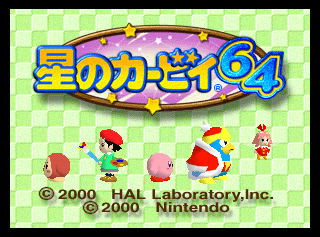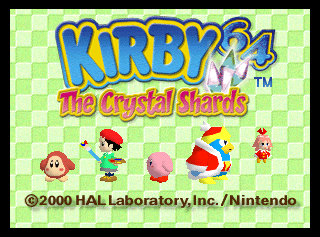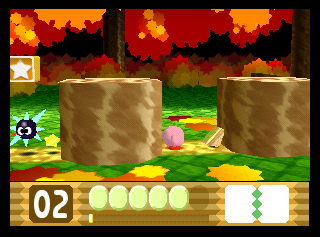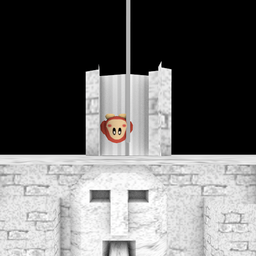Kirby 64: The Crystal Shards
| Kirby 64: The Crystal Shards |
|---|
|
Also known as: Hoshi no Kirby 64 (JP)
|
To do:
|
Eating enemies, floating around, fighting disembodied eyeballs... a Kirby game, except this one is in 3D and you can combine powers.
Contents
Sub-Pages
| Prerelease Info |
Unused Graphics
Early Art
Present at 0x9D8CC0 in the US version is some very, very early art.
| Image in-Game | Pre-release Picture |
|---|---|
 |
A similar set of portraits can be seen in use in early pre-release shots. Most notably, Kirby's animal friends were apparently meant to be in the game. In the final game, they only appear in a small cameo with the Stone and Cutter combination.
The numbers under "Kirby 64" could be a date. If so, it would be October 30, 1998, nearly a year and a half before the game's Japanese release. This would also align with the developers stating that they started work on the game shortly before Kirby's Dream Land 3 released in 1997.
Unused HUD
Among the graphics of the different HUD displays is this strange HUD of some sort that might be related to debugging.
Early Pop Star Forest Bush
| Unused | Used |
|---|---|
Hidden outside the skybox in Adeleine's introduction cutscenes are several bushes, one of which uses a different texture from the others. The normal bushes are given color through the use of shaders, but the unique bush has a colored texture. This is likely what all of the bushes in Pop Star stage 2 looked like earlier in development.
Unused Texture Transparency
Two of the textures in King Dedede's castle have transparency data that is not used by the game. The square wave pattern texture, used on multiple walls in the castle, could have doubled as battlements by hiding the top half of the pattern. The stained glass window texture has transparency for all of the black parts, which would allow it to be used as a light effect or allow more detailed wall textures to show through from behind. Early footage of the game shows the textures being used without transparency, suggesting that the change was made early on.
Unused Rock Star Boss Platform Design
The texture used by the ring-shaped platform in the Rock Star boss stage is designed to depict two different materials. However, the model only ever uses the bottom-right half of the texture, leaving the upper-left half unused. The shading suggests that this half may have been intended for the larger portions of the platform. The appearance of the material does not resemble any of the other materials used in any Rock Star stage.
Unused Test Rooms
| This page or section has one or more broken YouTube links. Please find an archived version of the video(s) or a suitable replacement. Specifically: The video was deleted. |
Enter the GameShark code 810D1F9A ????, where "????" is one of the below. This will replace Pop Star's first level.
| Value | Internal Name | Room Description |
|---|---|---|
| 1E30 | ABE200 | A plain green room with Adeleine. That's it. |
| 1E54 | ABE100 | A wide open area for testing different kinds of terrain. Each colored square uses a different material, and is labeled in Japanese. There are some occasional blocks. The materials are, from left to right: Ice (コオリ), Snow (ユキ), Sand (スナ), Wood (キ), Cloud (クモ), Grass (クサ), Iron (テツ), Mud (ドロ), Slippery (スベリ). |
| 1EE4 | ENETEST1 | Completely empty, so Kirby falls forever in a grey void. The name indicates that it may have been used to test enemy behavior. |
| 1F08 | ENETEST2 | A large room with a high ceiling and a painfully colorful grid on the back wall. The name indicates that it may have been used to test enemy behavior. |
| 1F2C | ITEM01 | A very wide room that contains a lot of food and some Invincibility Candies, Yellow Stars, and Blue Stars. There are blocks and pools of water, but they have no collision. |
| 1F50 | BREAKTEST1 | A basic room with some blocks to jump on. Some kind of broken background effect is used here, causing a white wavy texture to be overlaid in front of everything. |
On a side note, 1E9C (EXERCISE0) contains the How to Play demo. Interestingly, all the demos are in one room!
Unused Audio
To do:
|
The Sound Check, available after beating the game, contains a handful of unused tracks. It also lists the game's songs in a different order than the official soundtrack, likely the order they were implemented into the game.
Unused Music
An arrangement of the first animal friends theme in Kirby's Dream Land 3! It can be accessed as Music 002 in the Sound Check. Given its early placement in the game's files and the presence of the two other animal friends themes as Music 003 and 004 (both used; 003 is used for the Theater menu and 004 is used as a stage theme), they may have been used to test the game's sound format.
The classic victory dance theme of the series. Present as Music 061 in the Sound Check.
A shorter victory dance. Present as Music 062 in the Sound Check, the last entry.
Unused Sounds
いろはにほへと ちりぬるを (Iro ha nihoheto Chirinuru wo)
This is present in the Sound Test. It's the first two phrases of the traditional Japanese poem Iroha, the Japanese equivalent to the ABC song, repeated over and over in a sped-up voice. Due to how it ends, it was likely intended for the TVs in Stage 3 of Shiver Star. Present as Sound Effects 395 in the Sound Check.
Crash Debugger
This game has a crash debugger. To open it, crash the game in some way, then enter this button code:
- Z + R + L
- D-Up + C-Up
- A + D-Left
- B + D-Right
- D-Down + C-Down
The crash debugger consists of three pages. Press Z + R + L to scroll through them. The first page displays the type of crash and the registers, the second page displays a stack trace, and the third page displays different contents depending on the type of crash.
The same crash debugger can also be found in Super Smash Bros. and Pokémon Snap, both of which were also developed by HAL.
Debug Save Code
There is a cheat code that will set File 3 to 100% completion, presumably for debug purposes. In order to activate it, make it so the save files are in the following state:
- File 1 - doesn't matter
- File 2 - empty
- File 3 - initialized but not started
Reset the game, and when the HAL Laboratory and Nintendo logos appear, hold L on the second controller and enter the following button combo: C-Up, C-Up, R, C-Right, C-Left, and Start. The 1-up sound will play, and when you go to the save file screen, File 3 will be set to 100%. This code works on all the known original N64 versions of the game: Japan Rev. 0 through 3, USA, and Europe. It'll also work on the Wii U Virtual Console and Nintendo Switch Online versions but not the Wii Virtual Console or Kirby's Dream Collection versions since the N64 L Button isn't mapped to anything.
You can see the decompiled source code for the function behind this cheat code here.
Unseen Geometry
These models/geometry are used in the game, but cannot be seen through normal means.
Extra Tiny Fence Post
In the cutscene where Kirby meets Ribbon, there is a tiny copy of a fence post present in the scene. The extra fence post, which is smaller and more tapered than the other fence posts in the scene, is floating above the ground to Kirby's left. This tiny fence post is visible in the bottom-left portion of the screen when Kirby runs into the sunrise, showing up as one or two brown pixels just beneath the fence beam.
Waddle Dee's Rope
In the rising sand room of the first Rock Star stage, Waddle Dee breaks through the ceiling to give Kirby an exit. Hidden up in the exit hole is a rope model that loads with Waddle Dee. The rope is long enough to reach the floor, but it never moves and is not low enough to be seen. With Kirby's ability to fly, it makes rope unnecessary. Lowering the rope would have given little benefit to the player and would have only slowed down the scene.
Early Dark Matter
In the cutscene after Waddle Doo is defeated, the Dark Matter ball that flies up is a different model from the typical Dark Matter used in other cutscenes. The design resembles Dark Matter's appearance in earlier games, though this exact design is new. The eye is modeled out and protrudes from the body. The whole model uses 512 polygons, which is relatively high-quality for a Nintendo 64 game. Though, some other characters use more.
Regional Differences
| Japan | International |
|---|---|
 |
 |
Along with a necessary title change, the two copyrights were merged into a single line in the international version.
| Japan | International |
|---|---|
 |
 |
The fourth HUD option in the Japanese version of the game has an appearance similar to Japanese calligraphy, and replaces all numbers and icons with kanji. The international version changes it to a crayon-drawn theme.
| Japan | International |
|---|---|
 |
 |
One of the food items is a rice ball in the Japanese version and a sandwich in the international versions, continuing a running theme of removing Japanese foodstuffs. Oddly, Waddle Dee still "eats" an onigiri during the stage-ending picnic sequences in both versions.
- Pages missing developer references
- Games developed by HAL Laboratory
- Pages missing publisher references
- Games published by Nintendo
- Nintendo 64 games
- Pages missing date references
- Games released in 2000
- Games released in March
- Games released on March 24
- Games released in June
- Games released on June 26
- Games with unused areas
- Games with unused graphics
- Games with unused models
- Games with unused music
- Games with unused sounds
- Games with debugging functions
- Games with regional differences
- To do
- Broken YouTube Links
- Kirby series
Cleanup > Broken YouTube Links
Cleanup > Pages missing date references
Cleanup > Pages missing developer references
Cleanup > Pages missing publisher references
Cleanup > To do
Games > Games by content > Games with debugging functions
Games > Games by content > Games with regional differences
Games > Games by content > Games with unused areas
Games > Games by content > Games with unused graphics
Games > Games by content > Games with unused models
Games > Games by content > Games with unused music
Games > Games by content > Games with unused sounds
Games > Games by developer > Games developed by HAL Laboratory
Games > Games by platform > Nintendo 64 games
Games > Games by publisher > Games published by Nintendo
Games > Games by release date > Games released in 2000
Games > Games by release date > Games released in June
Games > Games by release date > Games released in June > Games released on June 26
Games > Games by release date > Games released in March
Games > Games by release date > Games released in March > Games released on March 24
Games > Games by series > Kirby series







